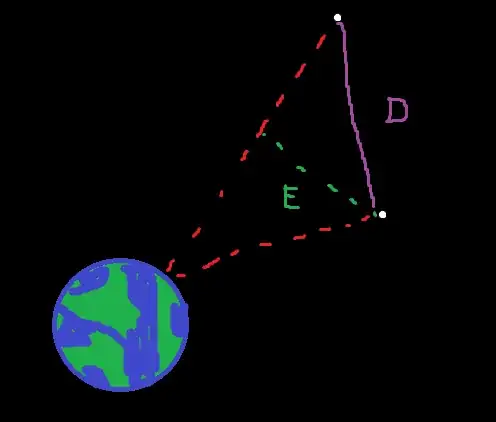At the begining I wish to apologise for naive question, but one thing puzzles me. Let's say we observe two stars that have average brightness. One can easily see that they are not points, but those lights have certain shape (it can be easily observed on a photographic image with longer exposure). When we count visible distance between those two objects, we can easily see that we could "fit" another thousand or two average sized stars between them, but not more. That leads me to question: those thousand or two average sized stars give distance that doesn't seem to be even a tiny fraction of an actual distance between those two stars. What am I missing?
2 Answers
If I'm understanding the question properly, the actual distance (represented in the diagram by $D$), is very different to the distance that we roughly 'see' with our eyes (represented by $E$). In general, the 'actual' distance will be much greater than the 'apparent' naive distance.
There are, of course, much larger problems with trying to use your method to estimate the distance $D$ between two stars, the largest being the fact that you can't really see the shape of the stars properly even with really big telescopes. Usually you figure out the size of stars from observing other things about it, like it's color and brightness.
- 7,145
What you are missing is that the size and the distance between two objects perceived by human eye turns out to be false due phenomena of diffraction at very large distances.You see, the limit of resolution of human eye is small. To know what I mean, consider 2 points of paper very close to each other.
Move your head away from paper until what you see is basically one dot, instead of two dots.This proves that actual distance between two objects is not equal to perceived distance(0 in this case from far away).
Similar is the case if you repeat the experiment with SQUARE dots.What you will perceive at large distance one circular dot. Thus the actual "story" of stars differs from perceived one.Therefore even if we try to estimate distance between stars with naked eye, by noting the angular subtend over eyes, our answer would differ significantly from actual one
Now coming to your comment on "Why some stars are bigger". PART of reason for that is that one star may be situated nearer to earth than the other. Do however note that diffraction effects take place here also, because stars may be of different color, and diffraction effects due different colors differ, due to different wavelengths.
This is also the reason why we can not see a sharply defined star instead of a blurry one WITH NAKED EYE.
- 485
